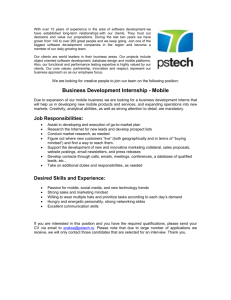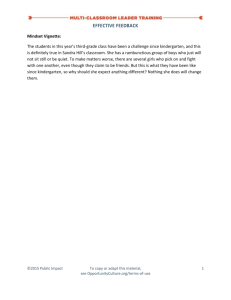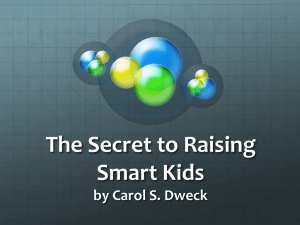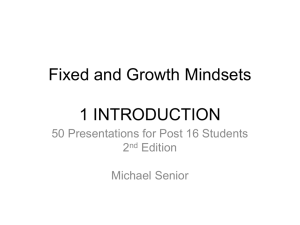Growth Mindset Research
advertisement
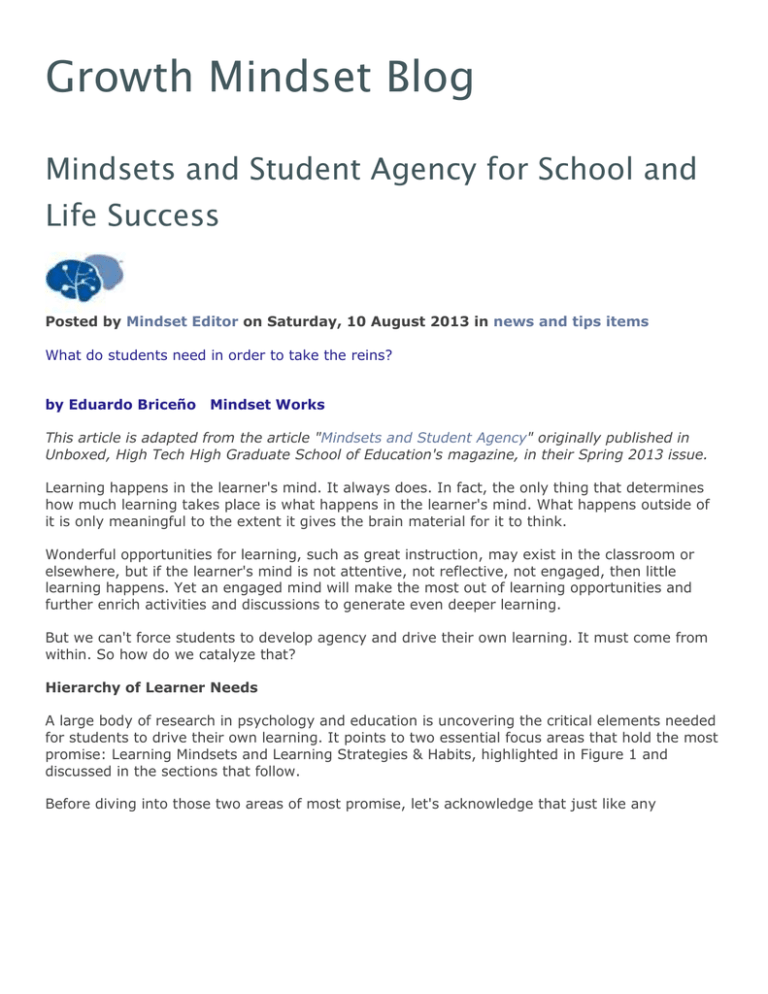
Growth Mindset Blog Mindsets and Student Agency for School and Life Success Posted by Mindset Editor on Saturday, 10 August 2013 in news and tips items What do students need in order to take the reins? by Eduardo Briceño Mindset Works This article is adapted from the article "Mindsets and Student Agency" originally published in Unboxed, High Tech High Graduate School of Education's magazine, in their Spring 2013 issue. Learning happens in the learner's mind. It always does. In fact, the only thing that determines how much learning takes place is what happens in the learner's mind. What happens outside of it is only meaningful to the extent it gives the brain material for it to think. Wonderful opportunities for learning, such as great instruction, may exist in the classroom or elsewhere, but if the learner's mind is not attentive, not reflective, not engaged, then little learning happens. Yet an engaged mind will make the most out of learning opportunities and further enrich activities and discussions to generate even deeper learning. But we can't force students to develop agency and drive their own learning. It must come from within. So how do we catalyze that? Hierarchy of Learner Needs A large body of research in psychology and education is uncovering the critical elements needed for students to drive their own learning. It points to two essential focus areas that hold the most promise: Learning Mindsets and Learning Strategies & Habits, highlighted in Figure 1 and discussed in the sections that follow. Before diving into those two areas of most promise, let's acknowledge that just like any other human being, students also need to meet their physiological needs such as food, safety (physical and emotional), and connection with others. The vast majority of children in the U.S. meet enough of their physiological needs that these are not a material hindrance on learning. For those who don't, we have a responsibility to provide these needs, at least while they're at school. We can feed students, foster a safe and bully-free environment, and cultivate a learning community in which all children value learning, feel acknowledged and are accepted. Essential Opportunity #1: The Four Learning Mindsets Aside from physiological needs, students' motivations and efforts are driven by their mindsets –a set of key beliefs they hold. The greatest untapped opportunity to improve learning in our schools is to deliberately work on developing the four Learning Mindsets that stand out in the research as deeply influencing student behavior, outcomes, and overall drive to learn, as documented by the University of Chicago CCSR's literature review Teaching Adolescents to Become Learners (Farrington, et al., 2012): Mindset #1: A Growth Mindset: "I can change my intelligence and abilities through effort." Among these beliefs, the most foundational and critical for us to focus on is the growth mindset, first identified and studied by Stanford professor Carol Dweck, Ph.D. Students with a growth mindset realize that their abilities to think and do are a result of their past behaviors. They see effort as what makes people smart, they are motivated to focus on continued growth, and they persist in the face of setbacks. On the other hand, when students see intelligence or abilities as fixed, they see effort as something only incapable people need, they shy away from challenge, and they disengage when things get hard (Mueller & Dweck, 1998). A growth mindset can be learned. When we teach a growth mindset, students work harder because they want to do so, they use more effective strategies, and they reach higher levels of achievement (Blackwell, et. al., 2007). While this benefits all students, it also breaks down negative stereotypes and thereby contributes to closing the achievement gap (Good, Aronson, & Inzlicht, 2003). The growth mindset is the most powerful lever to improve learning because it is the driver of student behavior that we're least aware of and least deliberate about building, and because it has the greatest impact on student behaviors required both to learn knowledge and skills and to build the other critical Learning Mindsets and Learning Strategies & Habits that improve students' ability to grow. Mindset #2: Self-Efficacy: "I can succeed." Related to the growth mindset is the belief that one can succeed (Bandura, 1986). Students must believe that they can achieve their goals, however they define those goals. If students think they need help or resources, they must see a path they can take in order to obtain the required help or resources. The stronger their growth mindset, the more students will seek ways to overcome adversities and search for alternate strategies to achieve their goals. Mindset #3: Sense of Belonging: "I belong in this learning community." When students feel they belong to a learning community, they become engaged in learning (Harvey & Schroder, 1963; Oyserman, Bybee, & Terry, 2006). This involves seeing peers as people who value going beyond one's comfort zone and learning about the world (that it is "cool" to do so), as well as feeling connected to those peers. When that is true, students associate learning activities and objectives with social rewards they value. Mindset #4: Relevance: "This work has value and purpose for me." Students engage in learning much more energetically and deeply when they value the knowledge and skills that they're working to acquire, or find them relevant or interesting (Eccles et al., 1983). That leads them to think deeply, question, pursue, and put their full selves into their work. Project-based learning and real-world connections are ways to foster relevance and help students explore passions, goals, and applications of learning. We can also have students reflect on and write about the relevance of their work or a learning experience they're about to embark on. Essential Opportunity #2: Learning Strategies & Habits Students with Learning Mindsets are energized, seek challenges and hold high expectations for themselves. But if they don't know what to do in order to meet those ambitious goals, they may develop a sense of helplessness. Or if they have misconceptions about what strategies are effective, they may try, fail, try again, fail again, and eventually question the Learning Mindsets. For example, if a student has the false impression that putting in effort is simply about the amount of time one spends on a task and not about deliberate practice, she may not achieve the progress she expects, which in turn may lead her to conclude that her abilities are fixed. We have the opportunity to teach not only knowledge and skills, but also the self-management and learning-to-learn skills needed in school and life (as well as the Learning Mindsets). We may think that students implicitly learn these skills as they do their work, but without explicit instruction and reflection, this understanding is not as solidly consolidated in the mind and understood (Schwartz, 1998). Research shows that we need experiences to deeply understand knowledge, but we also need explicit discussion and reflection to truly make sense of our experiences and apply our new understanding in different contexts. We must teach kids how to learn. We must teach them know-how such as: • how the brain works and how we can increase its capabilities, • how to manage our learning, including how to set learning goals, self-assess, approach new subjects, manage homework, dive deeper, learn from mistakes and know what to do when things get hard, • how to engage in deliberate practice to develop expertise, • how to foster innovation and creativity, • how to work in teams, • how to manage emotions, • how to develop willpower, • how to develop desirable habits through cues, routines and rewards, and • how to combine habits with tools to manage one self and one's learning. Learning Strategies & Habits include a host of self-management and learning-to-learn approaches and behaviors. Some strategies are more universal while others work better for different people or in different situations, but we must teach students how they can better manage themselves, approach learning and pursue their goals. These skills should be part of a basic educational foundation for all children. The Role of Instruction The Learning Mindsets and Learning Strategies & Habits enable students to seek and dive into learning opportunities. Of course, students also need quality instruction, guidance and learning activities. Learners need someone or something guiding them toward their zone of proximal development and pointing them to resources and experiences that will enable them to maximize personal growth. A teacher, coach or mentor skilled in teaching content and academic skills is invaluable. However, we must recognize that instructional practices, while critical, are not enough, at least as traditionally defined (that is, when not encompassing instruction on mindsets and learning strategies). Learning mindsets, strategies and subject matter instruction are layers that we need to work on largely concurrently, not just one after the other. They reinforce one another and learning on all three layers is ongoing. The transition to the Common Core appropriately demands more of students to better prepare them for success. In order to succeed in that transition we must also shift the learners' mind from passive detachment to active engagement and challenge-seeking. We need to develop in students the mindsets, strategies, and habits that cultivate student agency so that students can thrive not only in school but beyond. As we rethink teaching and learning in our transition to Common Core instruction, let's take the opportunity to also incorporate student agency practices. Realizing Learning Mindsets and Learning Strategies & Habits in Schools This work can happen in today's schools. At Mindset Works we serve hundreds of schools that are increasing student agency and achievement through deliberate focus on Learning Mindsets and Learning Strategies & Habits. Here's how they do it: Start with the adults: Research shows that students' mindsets are heavily influenced by the interactions they have with people around them. For example, studies show that when we praise kids for being smart when they perform well, we inadvertently put them in a fixed mindset. They start focusing on trying to look smart, avoid challenge, see effort as a sign of weakness, and fall apart when things get hard (Mueller & Dweck, 1998). Psychology research clearly shows that language that praises students' intelligence or abilities backfires and leads to students' self-doubt and avoidance of challenge. In order to create school and community environments in which students value effort and growth, we must educate teachers and parents on relevant research, work to foster a growth mindset in adults, and align around school practices that create and deepen student agency, including ensuring adults serve as role model lifelong learners. Expanding this alignment to include parents is also helpful. Whether schools use the Mindset Works® EducatorKit to guide this alignment or develop their own, this explicit work on school culture and practices is an important foundation. Explicitly cultivate students' Mindsets and Learning Strategies: Just like anything else we teach students, we must explicitly teach Learning Mindsets and Learning Strategies & Habits for students to take on the beliefs and incorporate strategies into daily living. It is helpful to teach students how their brains work and how to strengthen them, as well as effective learning strategies, tools and habits that best enable them to manage themselves. This is best done as a whole school effort that builds a common understanding and language in all students, educators and parents, so that everyone can refer to that common understanding in everyday teaching and learning. Doing this work not only shifts students' mindsets but also adults' mindsets. Our blended learning program, Brainology®, is one way hundreds of schools accomplish this. This work is possible today. Embed strategies in everyday teaching & learning: Once teachers, students, and families share common foundational beliefs and practices, the work continues to embed practices that foster student agency in everyday life. Teachers continue to work on language, instructional practices, and their own beliefs, while students work on their mindsets, learning strategies and habits. This does not take additional time. It is about the way we do our daily work, interact with one another and manage ourselves, and it leads to deep beliefs and habits that drive all of students' behaviors. For example, teachers can explicitly frame lessons or projects as opportunities to work on what we don't know and go beyond our comfort zone to build capabilities. We can make better use of student mistakes and confusion as opportunities to learn, clarify and study the learning process. We can give feedback to students focused on their behavior, their choices, their strategies, rather than on being smart or talented. We can teach performance skills, such as those in common core standards, using content that furthers Learning Mindsets and Learning Strategies & Habits, such as info texts on how people who struggled reached success, or on scientific research about what makes for effective selfmanagement and learning, or about the relevance of our school work to our communities and life. We can have students chart their growth so they can view their improvement over time, and we can have them build growth mindset portfolios exemplifying times in which they took risks and achieved doing something they couldn't do before. We can encourage student goal-setting and reflection on what is working and not working in their learning strategies. And we can serve as role models so students can see that everyone in our community is a lifelong learner, seeks feedback and takes on opportunities to grow. Transition to student independence: Once we develop these mindsets, strategies, and habits, we also need to help students own them after they graduate. We can help them transition habits from being driven by teachers and the school environment to being self-driven. Older students can mentor younger students around mindsets and learning strategies, and we can gradually remove the school-dependent cues so that students develop self-driven cues needed to maintain effective habits over their lives. We Can Do It How can we best prepare students for a world that will require more of them? The most important resource in education reform is the learner's mind. We need to re-ignite the hunger for learning that many students lose along the way. Explicit and embedded work on Learning Mindsets and Learning Strategies & Habits puts students in the driver seat of learning and gives them direction and tenacity to chart their paths to success. References and Resources To learn more about the growth mindset or expose it to others, see Eduardo's TEDx talk: http://www.youtube.com/watch?v=pN34FNbOKXc For resources to build Learning Mindsets and Learning Strategies & Habits see: http://www.mindsetworks.com/free-resources/ Bandura, A. (1986). Social foundations of thought and action: A social cognitive theory. Englewood Cliffs, NJ: Prentice Hall. Blackwell, L.S., Trzesniewski, K.H., & Dweck, C.S. (2007). Implicit theories of intelligence predict achievement across an adolescent transition: A longitudinal study and an intervention. Child Development, 78. 246-263, Study 1.) Dweck. C. S. (2006). Mindset: The New Psychology of Success. New York: Random House. Eccles J.S., Adler, T.F., Futterman, R., Goff, S.B., Kaczala, C.M., Meece, J.L., and Midgley, C. (1983). Expectancies, values, and academic behaviors. In J.T. Spence (Ed.), Achievement and achievement motivation (pp. 75-146). San Francisco: W.H. Freeman. Farrington, C.A., Roderick, M., Allensworth, E., Nagaoka, J., Keyes, T.S., Johnson, D.W., & Beechum, N.O. (2012). Teaching adolescents to become learners. The role of noncognitive factors in shaping school performance: A critical literature review. Chicago: University of Chicago Consortium on Chicago School Research. Good, C., Aronson, J., & Inzlicht, M. (2003). Improving adolescents' standardized test performance: An intervention to reduce the effects of stereotype threat. Applied Developmental Psychology, 24, 645-662. Harvey, O.J., and Schroder, H.M. (1963). Cognitive aspects of self and motivation. In O. J. Harvey (Ed.), Motivation and social interaction-cognitive determinants. (pp. 95-133). New York: Ronald Press. Mueller, C. M. & Dweck, C. S. (1998). Intelligence praise can undermine motivation and performance. Journal of Personality and Social Psychology, 75, 33-52. doi:10.1037/00223514.75.1.33.Pellegrino, James W. & Hilton, Margaret L., Editors. National Research Council. (2012). Education for Life and Work: Developing Transferable Knowledge and Skills in the 21st Century. Washington, DC: The National Academies Press. Oyserman, D., Bybee, D., and Terry, K. (2006). Possible selves and academic outcomes: How and when possible selves impel action. Journal of Personality and Social Psychology, 91, 188204. Schwartz, D. L. & Bransford, J. D. (1998). A time for telling. Cognition & Instruction, 16, 475522. About Eduardo Briceno Eduardo Briceño is the Co-Founder and CEO of Mindset Works, an organization that helps schools and other organizations cultivate a growth mindset culture. The growth mindset was discovered by Stanford professor and Mindset Works co-founder Carol Dweck, Ph.D., and is described in her book Mindset: The New Psychology of Success (http://www.mindsetonline.com). Mindset Works offers Brainology, an innovative blended learning program to teach a growth mindset to students, teachers and schools, as well as teacher professional development and tools (http://www.mindsetworks.com/brainology/). About Mindset Works Mindset Works was co-founded by one of the world's leading researchers in the field of motivation, Stanford University professor Carol S. Dweck, Ph.D. and K-12 mindset expert Lisa S. Blackwell, Ph.D. The Company translates psychological research into practical products and services to help students and educators increase their motivation and achievement.
